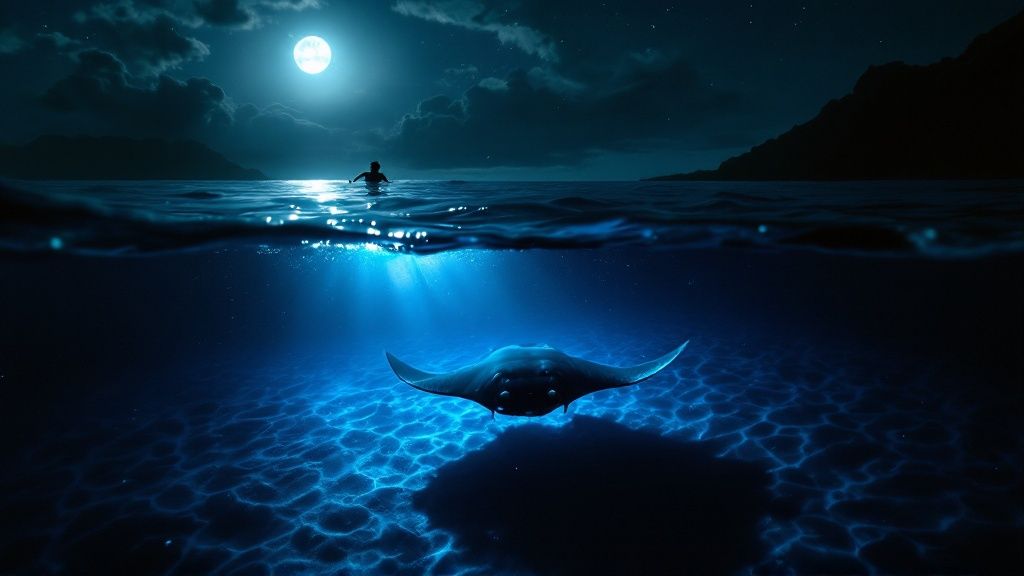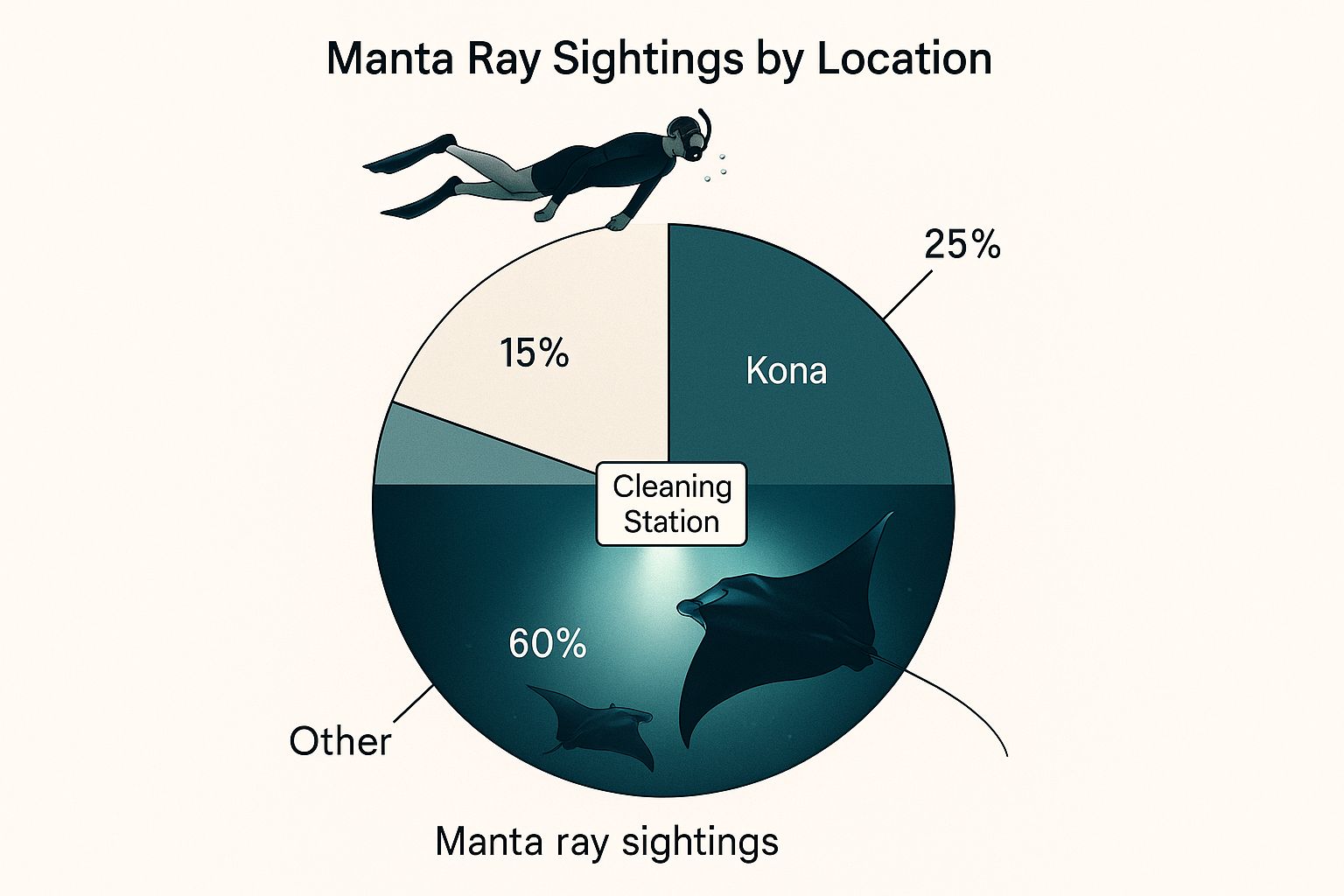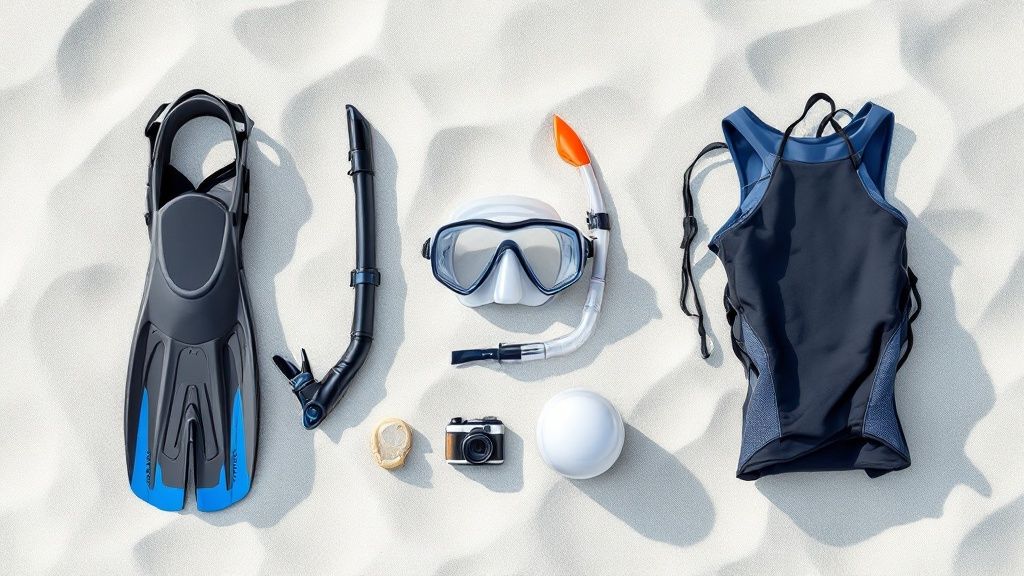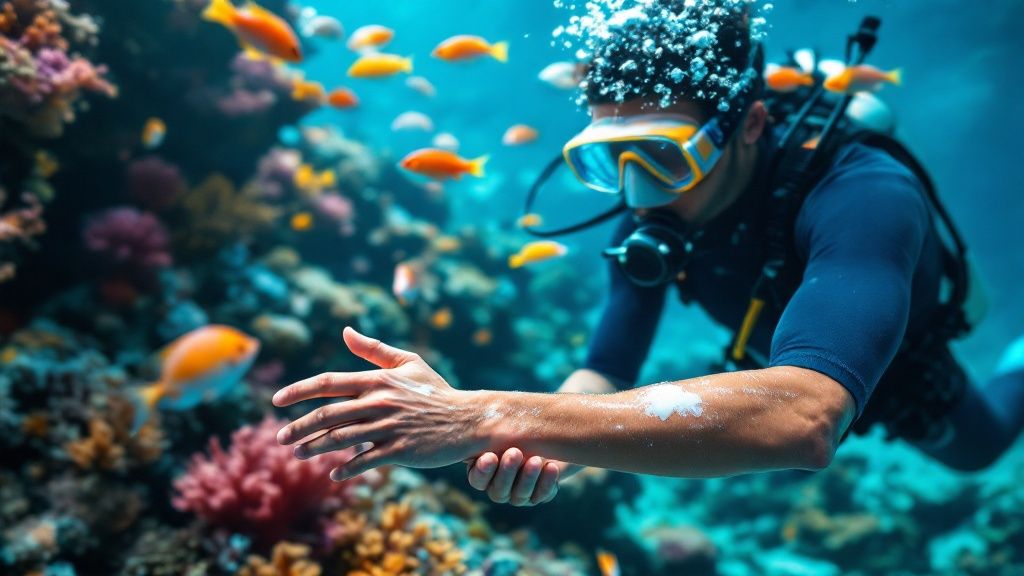Manta Ray Snorkel Big Island: Unforgettable Adventure Tips

The Magic of Manta Ray Snorkeling on Hawaii's Big Island
There's something truly special about floating in the Pacific Ocean at sunset, watching magnificent manta rays rise from the depths. Manta ray snorkeling on the Big Island has become a must-do, an experience that lingers long after the trip ends. What makes this location so unique? It's the blend of ecological factors and cultural respect that elevates a simple snorkel trip to something unforgettable.
The Kona Coast: A Manta Ray Haven
The Kona Coast provides remarkably consistent and up-close manta ray encounters. This is thanks to the special oceanographic conditions that create ideal feeding grounds for these gentle giants. Plankton, the manta ray's main food source, flourishes in these nutrient-rich waters. The underwater landscape, with its shallow, protected bays, acts like a natural plankton trap. This consistent food source means mantas regularly visit these locations, practically guaranteeing snorkelers a sighting. Popular spots like Manta Village and Manta Heaven live up to their names. Want to learn more about swimming with these incredible creatures? Dive deeper with this guide: Manta Ray Snorkel Kona Hawaii: The Ultimate Experience Guide.
The Kona Coast attracts about 80,000 visitors each year specifically to snorkel or dive with manta rays. The impressive 80-90% sighting success rate during tours fuels this popularity. This high probability of an encounter, combined with the area's natural beauty, makes the Big Island a top destination for manta ray snorkeling. More detailed statistics can be found here.
A Cultural Significance
Beyond the ecological reasons, the cultural importance of manta rays in Hawaiian tradition adds a deeper meaning to the experience. In ancient Hawaiian culture, mantas were considered aumakua, or family guardians, symbolizing wisdom and grace. This reverence continues today, promoting respect and appreciation among locals and visitors. This deep connection transforms a wildlife encounter into something much more meaningful.
An Awe-Inspiring Encounter
Seeing these graceful giants up close is truly awe-inspiring. Their effortless glide through the water, intricate patterns, and gentle nature leave a lasting impression. Imagine floating on the surface as these massive shadows pass beneath, their wingspans reaching up to 18 feet. It's a humbling reminder of the ocean's vastness and the delicate balance of life within. The combination of consistent sightings, cultural significance, and the sheer majesty of the mantas is what makes Big Island manta ray snorkeling such a magical experience.
Prime Locations: Where to Find Big Island's Manta Rays
Not all manta ray viewing spots are created equal. The Big Island, however, boasts exceptional locations, each with unique advantages for witnessing these gentle giants. Let's explore these prime locations and discover what makes them so attractive to manta rays and ideal for snorkelers.
Manta Village: The Original Hotspot
Manta Village, off the coast of Keauhou, south of Kona, earned its name for a good reason. Considered the original manta ray night snorkel spot, it has an incredibly high sighting rate. The calm, shallow waters are perfect for beginners and experienced snorkelers. The unique underwater topography creates a natural trap for plankton, the manta ray's primary food source. This means regular manta ray visits, offering snorkelers an almost guaranteed encounter. You might be interested in: our sitemap for more activities.
Manta Heaven (Garden Eel Cove): A Spectacle of Grace
North of Kona International Airport sits another renowned spot: Manta Heaven, also known as Garden Eel Cove. While the sighting rate might be slightly lower than Manta Village, the potential rewards are often greater. Manta Heaven is known for attracting larger numbers of manta rays, turning a simple snorkel into a breathtaking ballet. Lights from nearby resorts historically attracted plankton, and tour operators now use specialized lights to recreate this effect, drawing in these majestic creatures.
Kona Coast: A Hub of Manta Activity
The Kona Coast deserves recognition as a prime manta ray location. The nutrient-rich waters support a thriving plankton population, the key to attracting these filter feeders. From 2009 to 2014, researchers documented over 320 individual manta rays in the Kona Coast area, highlighting its significance as a manta ray habitat. This research underscores the importance of conservation and responsible tourism. Find more detailed statistics here: Manta Ray Advocates. Many operators offer tours departing from various points along the coast, providing a range of viewing options.
Choosing the Right Location for You
The best location depends on your priorities. Manta Village offers the highest likelihood of a sighting, perfect for those with limited time. Manta Heaven offers the chance to see more mantas at once, ideal for photographers or those seeking an immersive experience. Other Kona Coast locations provide more intimate encounters, potentially with fewer mantas.
To help you decide, the following table compares key factors at these popular manta ray snorkel spots:
Top Manta Ray Snorkel Locations on Big Island
| Location | Success Rate | Best Time | Water Conditions | Crowd Level | Special Features |
|---|---|---|---|---|---|
| Manta Village | Very High | Night | Calm, Shallow | Moderate | Original Hotspot |
| Manta Heaven | High | Night | Moderate Depth | High | Potential for Large Groups |
| Kohala Coast | Moderate | Day/Night | Variable | Low | Intimate Encounters |
The table summarizes the key differences between the locations, highlighting Manta Village's high success rate and Manta Heaven's potential for larger groups. The Kohala Coast offers a less crowded experience, ideal for those seeking a more intimate encounter.
This data chart visually represents the average number of mantas seen at each location and the sighting rates.

As the data chart shows, while Manta Village boasts a higher sighting rate, Manta Heaven often delivers a greater number of mantas per sighting. This emphasizes the trade-off between a guaranteed sighting and the potential for a truly spectacular experience. Consider these factors when choosing your ideal manta ray snorkel adventure.
Selecting the Perfect Manta Ray Tour Experience
The difference between a typical manta ray encounter and a truly unforgettable one often lies in choosing the right tour operator. This section explores key factors to consider when booking your manta ray snorkel Big Island adventure, helping you look beyond the marketing and focus on what truly matters.
Key Considerations for an Unforgettable Experience
Even seasoned travelers sometimes regret not knowing certain things before booking. Here are some crucial aspects to research:
-
Group Size: Smaller groups offer a more personalized experience and minimize disruption to the manta rays. A crowded tour can diminish the magic.
-
Vessel Type: Think about your comfort level. Larger boats provide stability, while smaller rafts offer a more intimate, albeit potentially bumpier, ride.
-
Equipment Quality: Well-maintained snorkel gear, including properly fitted masks and fins, is crucial. Inquire about wetsuit types, especially for night tours when water temperatures can decrease.
-
Guide Expertise: Experienced guides enrich the tour with insights into manta ray behavior and responsible interaction. Their knowledge and enthusiasm greatly impact the overall experience.
Questions to Ask Potential Tour Operators
Asking the right questions can reveal an operator's commitment to both guest satisfaction and manta ray conservation.
-
What is your group size limit? This indicates the operator's focus on experience quality.
-
What type of vessel do you use? Select a boat that matches your comfort and desired level of intimacy.
-
How experienced are your guides? Knowledgeable guides provide more valuable information about manta ray behavior.
-
What are your conservation practices? Responsible operators prioritize the well-being of the manta rays.
Evening vs. Midnight Excursions: Which is Right for You?
Both early evening and midnight manta ray snorkel Big Island excursions have unique benefits. Early evening tours often coincide with sunset, providing a stunning backdrop. Midnight tours, however, can be more exclusive, potentially with fewer people and a different view of manta ray feeding habits. Consider your photography goals, as lighting will vary significantly.
Luxury Boats vs. Intimate Rafts: Balancing Comfort and Budget
Choosing between a luxury boat and a smaller raft depends on your priorities. Luxury boats offer more comfort and stability, often with amenities like restrooms and refreshments. Rafts provide a closer-to-nature feel and more personal interaction with guides and fellow snorkelers. Factor in your budget, as luxury tours are typically more expensive. Explore our site navigation guide: Navigating Our Site. While the Big Island is famous for manta rays, other islands like Oahu offer different experiences. You might consider exploring Honolulu. Ultimately, the right tour operator and experience type will ensure your manta ray encounter is both memorable and contributes to the conservation of these incredible animals. Careful planning transforms a simple snorkel trip into a truly meaningful experience.
Preparing for Your Night Ocean Adventure With Mantas

Even seasoned snorkelers can find a nighttime manta ray snorkel on the Big Island uniquely challenging. This guide helps you swap pre-trip nerves for excitement by preparing you physically, mentally, and with the right gear. We'll cover common concerns about navigating the dark ocean, handling currents, and interacting with these gentle giants.
Physical and Mental Readiness for Your Manta Ray Snorkel
Physical preparation is essential for maximizing your enjoyment. Snorkeling is generally low-impact, but extended time in the water requires a base fitness level. Practicing swimming and treading water in a pool beforehand can greatly improve your comfort and stamina. Some tours might involve a short swim from the boat to the main viewing area.
Mental preparedness is just as vital, especially if you're new to night snorkeling. Visualize yourself calmly floating, surrounded by these magnificent creatures. Remember, manta rays are filter feeders and pose no threat to humans. Focusing on the unique opportunity to observe them in their natural habitat can transform anxiety into anticipation.
Essential Gear for a Night Snorkel
The right gear ensures both comfort and safety during your Big Island manta ray adventure. A well-fitting wetsuit provides crucial warmth, particularly at night when water temperatures can dip. The ideal wetsuit thickness for Hawaiian waters varies seasonally, typically between 3mm and 5mm. Check with your tour operator for recommendations based on the time of year.
A comfortable, leak-free mask and snorkel are vital for clear vision and easy breathing. Fins, usually provided by tour operators, should fit snugly without being restrictive.
Read also: our sitemap for more activities.
Expert Tips for a Smooth Experience
Seasoned guides offer valuable advice to enhance your Big Island manta ray experience:
- Practice boat entry and exit procedures for night water activities. This often means using a boat ladder in low light.
- Discuss any concerns or physical limitations with your guide. They can offer personalized support for a safe, comfortable experience.
- Learn proper lighting techniques for night snorkeling. Guides use specialized lights to attract plankton and illuminate the manta rays without disturbing them.
- Understand potential currents and how to react. Hawaiian waters can experience strong currents, making it crucial to follow your guide's instructions.
To help you pack, here's a handy checklist:
Before the table, add a brief introduction: "Use this checklist to ensure you're fully prepared for your manta ray snorkel adventure:"
| Item/Preparation | Importance | Notes | Provided by Tour? |
|---|---|---|---|
| Wetsuit (3mm-5mm) | Essential | Keeps you warm in cooler night waters | Often, but confirm with tour operator |
| Mask and Snorkel | Essential | Ensures clear vision and comfortable breathing | Often, but bringing your own ensures a perfect fit |
| Fins | Important | Improves mobility in the water | Usually provided |
| Towel | Important | For drying off after the snorkel | Bring your own |
| Waterproof Bag | Recommended | Protects valuables from water | Bring your own |
| Motion Sickness Medication | Recommended | If prone to seasickness | Bring your own |
| Reef-Safe Sunscreen | Recommended | Protects your skin and the environment | Bring your own |
After the table, add a short conclusion: "By packing these essentials and following the provided advice, you’ll be well-prepared for an unforgettable manta ray encounter."
Capturing the Magic: Photography Tips
For underwater photographers, capturing these majestic creatures requires special planning:
- Invest in a waterproof housing for low-light conditions.
- Use a red filter to correct color distortion in the water.
- Practice underwater photography skills in a pool beforehand.
- Respect the manta rays; avoid flash photography.
By addressing your physical and mental readiness, packing the correct equipment, and heeding expert advice, you'll be perfectly prepared for an incredible night ocean adventure. This careful planning will ensure a safe and enriching encounter with the magnificent manta rays of the Big Island.
The Manta Experience: From Sunset to Unforgettable Encounter
As the sun dips below the horizon, casting a warm glow across the Hawaiian sky, your manta ray snorkel adventure on the Big Island begins. The boat ride from the harbor buzzes with anticipation. The crew's preparations add to the excitement as everyone looks forward to the night's magical encounter.
Setting Sail and Preparing for the Encounter
The sunset cruise to the manta ray viewing site offers stunning views of the Kona Coast. As you approach locations like Manta Village or Manta Heaven, the guides provide a briefing on in-water etiquette and essential safety procedures. This information is crucial for both the protection of the manta rays and a respectful, enriching experience. You'll learn how to position yourself in the water without disturbing these gentle giants.
Entering the Water and the First Sightings
Entering the water varies depending on the tour and location. Some tours use a platform, while others involve a gentle slide from the boat. Once in the water, you'll hold onto a flotation device, usually a surfboard or large float, equipped with lights. These lights attract plankton, the manta rays' primary food source. Before long, dark shapes begin to emerge from the depths—the majestic manta rays.
The Manta Ballet: Observing Their Feeding Behaviors
As the mantas gather, their mesmerizing feeding ritual begins. They glide through the illuminated water, mouths agape, filtering plankton. Their intricate barrel rolls and loops create a captivating underwater ballet. Observing these creatures up close, with wingspans sometimes reaching 18 feet, is a truly awe-inspiring sight. Witnessing their unique feeding behaviors showcases their remarkable agility and elegance.
A Sensory Symphony: Sounds, Temperature, and Emotion
The manta ray experience engages more than just your vision. The underwater world at night is filled with intriguing sounds, from the gentle whoosh of the manta rays' wings to the clicks they produce while feeding. The cooler water temperature emphasizes the importance of a proper wetsuit. However, the most powerful aspect of this experience is the emotional connection you feel being so close to these magnificent creatures in their natural habitat. It's a humbling reminder of the ocean's wonders and the critical importance of conservation. This incredible encounter will undoubtedly stay with you long after you leave, capturing the true magic of a manta ray snorkel experience on the Big Island.
Embracing Ethical Manta Ray Encounters on Big Island

A Big Island manta ray snorkel adventure is an unforgettable experience. But to truly make it special, we need to prioritize the well-being of these gentle giants. This means understanding and following responsible practices that benefit both the manta rays and the overall quality of your encounter.
Understanding the Importance of Responsible Practices
Responsible tourism is crucial for manta ray conservation. These incredible animals face threats from fishing entanglement and habitat degradation. By choosing ethical tour operators and following interaction guidelines, we can help protect them. For instance, touching manta rays can damage their protective mucus layer, leaving them vulnerable to infection.
Manta Ray Interaction Guidelines: The Science Behind the Rules
Interaction guidelines are based on the science of manta ray behavior and biology. Mantas are filter feeders, relying on plankton. Chasing them or trying to ride them disrupts their feeding and causes stress, impacting their health. Excessive noise and sudden movements can also frighten them and disrupt their natural behaviors.
Identifying Truly Responsible Tour Operators
Many operators claim to be "eco-friendly." But how can you tell which ones are truly committed to conservation? Look beyond marketing and ask questions. A responsible operator will be transparent about their conservation efforts and follow established guidelines. They'll limit group sizes to minimize disturbance, prioritize the animals' well-being, and educate guests about responsible interaction. Look for certifications or affiliations with conservation organizations. You can find more information on reputable tour operators on our sitemap for activities and tours.
Supporting Long-Term Manta Ray Conservation
Your contribution to conservation goes beyond your snorkel trip. Donating to reputable organizations that fund manta ray research helps inform conservation strategies. Participating in citizen science programs, like reporting sightings, provides valuable data to researchers. Educating yourself and others raises awareness and promotes responsible behavior. Even small actions make a difference. By embracing ethical practices and supporting conservation, we can ensure future generations experience the wonder of these magnificent creatures.
Creating Lasting Memories Beyond Your Manta Adventure
Your manta ray snorkel Big Island experience will undoubtedly be a highlight of your trip. But how can you extend this magic and further connect with Hawaii's incredible marine ecosystem? This section offers ways to build on this amazing experience, ensuring the memories last well after you've returned home.
Complementary Ocean Adventures
Your manta ray adventure is just the start. The Big Island offers many other ocean activities to enrich your trip. Consider a dawn dolphin swim, where you'll witness these fascinating creatures in their natural environment. Or, explore hidden tide pools, teeming with colorful fish and other unique marine life. These less-traveled adventures provide a different perspective on Hawaii's diverse ocean.
Preserving Your Underwater Memories
Capturing the wonder of your manta ray encounter is essential. Journaling right after your snorkel allows you to document the vivid details, from the refreshing feel of the water to the graceful movements of the mantas. Organize your photos, and consider creating a dedicated album or slideshow. Choose a meaningful souvenir that supports conservation, like artwork by local artists or items from organizations working to protect manta rays.
Continued Connection Through Citizen Science and Education
If you're captivated by manta rays, consider staying involved after your visit. Citizen science programs provide opportunities to contribute to ongoing research. You could report manta ray sightings, assisting researchers in tracking their movements and population. Virtual adoption initiatives let you support individual manta rays and further conservation. Learn more in our article about our services and offerings. Educational resources, such as documentaries and online courses, can expand your understanding of these magnificent animals and their crucial role in the ocean's health.
Extend the Magic With Kona Snorkel Trips
Ready for your own unforgettable manta ray snorkel experience? Kona Snorkel Trips offers excellent tours focused on both guest satisfaction and manta ray conservation. Our knowledgeable guides, commitment to sustainable practices, and small group sizes guarantee a truly magical encounter. Book your adventure today!
